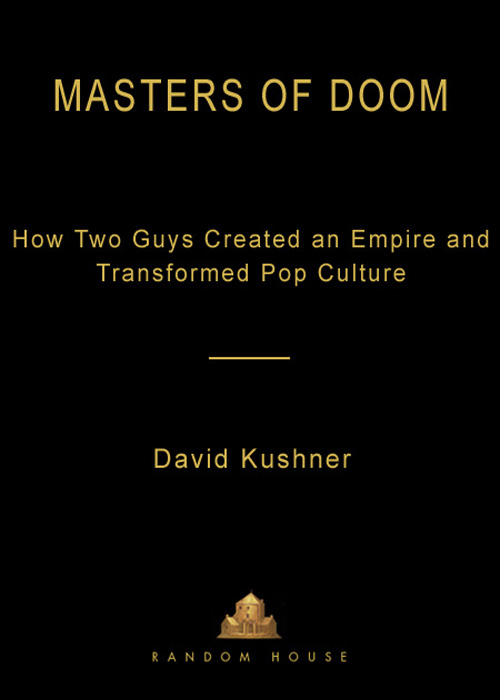
Masters of Doom
How Two Guys Created an Empire and Transformed Pop Culture
فرمت کتاب
ebook
تاریخ انتشار
2003
Reading Level
7
ATOS
8.1
Interest Level
9-12(UG)
نویسنده
David Kushnerشابک
9781588362896
کتاب های مرتبط
- اطلاعات
- نقد و بررسی
- دیدگاه کاربران
نقد و بررسی

April 28, 2003
Long before Grand Theft Auto
swept the video gaming world, whiz kids John Romero and John Carmack were shaking things up with their influential—and sometimes controversial—video game creations. The two post-adolescents meet at a small Louisiana tech company in the mid-1980s and begin honing their gaming skills. Carmack is the obsessive and antisocial genius with the programming chops; Romero the goofy and idea-inspired gamer. They and their company, id, innovate both technologically and financially, finding ways to give a PC game "side-scrolling," which allows players to feel like action is happening beyond the screen, and deciding to release games as shareware, giving some levels away gratis and enticing gamers to pay for the rest. All-nighters filled with pizza, slavish work and scatological humor eventually add up to a cultural sea change, where the games obsess the players almost as much as they obsess their creators. Fortunately, journalist Kushner glosses over Carmack and Romero's fame, preferring to describe the particulars of video game creation. There are the high-tech improvements—e.g., "diminished lighting" and "texture-mapping"—and pop cultural challenges, as when the two create an update of the Nazi-themed shooter Castle Wolfenstein. The author gives his subjects much leeway on the violence question, and his thoroughness results in some superfluous details. But if the narration is sometimes dry, the story rarely is; readers can almost feel Carmack and Romero's thrill as they create, particularly when they're working on their magnum opus, Doom. After finishing the book, readers may come away feeling like they've just played a round of Doom
themselves, as, squinting and light-headed, they attempt to re-enter the world.

Starred review from April 1, 2003
Mentioned only briefly in Van Burnham's Supercade: A Visual History of the Video Game Age, 1971-1984 and Steven Kent's The Ultimate History of Video Games, John Carmack and John Romero, originators of the world-famous video games Doom and Quake, garner an entire work here. Freelance journalist Kushner tells the story of two creative geniuses whose meteoric rise to fame and fortune in the 1990s resulted in enormous personal tensions that eventually drove them apart. In the wake of their success and subsequent corruption, they left a blueprint for the video games of today whose violence at once seduces and enrages us. Carmack and Romero introduced into video games the concept of "first-person shooters," which, years later, prompted a number of multimillion-dollar lawsuits over the influence that games like Doom had on the teenage gunslingers in the Columbine and Paducah tragedies; those suits were eventually thrown out. This is an especially fascinating read for longtime gamers who grew up in the 1980s initially enraptured by Asteroids and continued as devout players during the incredible evolution of realism in action-based video games. It will also intrigue followers of popular culture in general. Highly recommended for both public and academic libraries.-Joe J. Accardi, Harper Coll. Lib., Palatine, IL
Copyright 2003 Library Journal, LLC Used with permission.

November 1, 2003
Adult/High School-John Romero and John Carmack started programming games as teens. After they met, they became the first to make a video game on the PC that scrolled smoothly. In their 20s, they went on to create the hugely popular and controversial video games Doom, Wolfenstein 3-D, and Quake. But the passions that drove them to stay up late night after night, living on pizza and Cokes, drove them apart, causing Romero to leave to form his own company. The book traces their successes and failures, giving some insight into what it means to be a video-game designer, and is liberally sprinkled with humor, much of it from the twisted minds of the programmer/gamers themselves. Readers may not find the individuals likable, but they will be fascinated by watching what happens to them. While much of the story takes place in the '90s, the book continues on into the 21st century, where Carmack's Quake 3 is still heavily played and Romero's Daikatana has become one of the most hyped failures in video-game history. The company the young men founded, id Software, continues to be a force in gaming. Both video-game players and budding venture capitalists will find something entertaining and educational here.-Paul Brink, Fairfax County Public Library, VA
Copyright 2003 School Library Journal, LLC Used with permission.

Starred review from April 1, 2003
Kushner has cracked open the dark world of John Carmack and John Romero, the authors of the blockbuster computer games Wolfenstein 3D, Doom, and Quake. Reading this fascinating underground tale is as addictive as the games themselves. It is the ultimate revenge of the nerds: two obsessed gamers who were told that their interests had no redeeming value, their hacker ethic dismissed as borderline delinquent, forged their driven creative genius in programming and design to create the most wildly innovative and popular computer games of the 1990s. Using low-cost shareware distribution, they grew so big so fast that these 20-something renegades soon found themselves courted by the likes of Bill Gates. Unfortunately, Gates was not the only one who noticed. The games' bizarre violence finally got them caught up in controversy involving Columbine and the U.S. Senate, and they unwittingly found themselves victims of their own success. This is a true antihero story of our time, complete with the infamous all-night programming sessions saturated in pizza and Diet Coke, computer geeks turned rock stars spawning an entire cyberculture. "We are not worthy."(Reprinted with permission of Booklist, copyright 2003, American Library Association.)

























دیدگاه کاربران